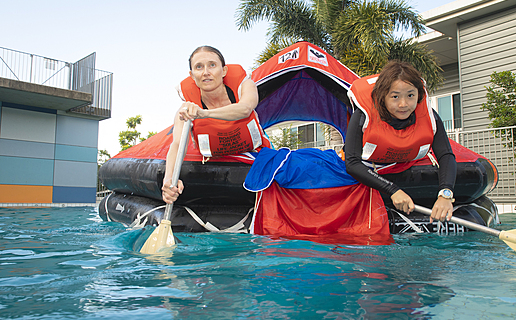Search The GBRIMC Website
Facilities
When you choose to study at Great Barrier Reef International Marine College (GBRIMC), you will have access to a comprehensive range of fully-equipped on-site training resources including:
- Full Mission Bridge Simulator
- Tug-Optimised Bridge
- Desktop simulators
- Multi-purpose Emergency Response Training Simulator (MERTS)
- Engineering workshops
- Immersion pool
- Training vessel

All facilities are available for hire. For more information call (+61 7) 4041 9813 or email
Full Mission Bridge Simulator
Our Kongsberg Digital K-SIM Navigation simulator is a STCW and DNV compliant Class-A Bridge Simulator. The Full Mission Bridge is equipped with two independent ECDIS consoles (Kongsberg Digital K-Bridge), two independent RADAR consoles with full ARPA function, Pilot Plug and WiFi AIS network for Portable Pilotage Units and the controls required to operate a range of propulsion and steering systems, while offering a 270 degree field of vision. The Full Mission Bridge is also integrated with OMC International’s Dynamic Under Keel Clearance System. The simulator’s integrated database and hydro-dynamic software allows operators to modify the experience according to student requirements. Digital models of ports from around the world, including major Australian ports, have been pre-programmed into this state-of-the-art system.
It incorporates:
- DNV Class-A Bridge Simulator
- Chart and communication table
- Control Room
- Debrief Room.
The simulator’s integrated database and hydro-dynamic software allows operators to modify the experience according to student requirements. Digital models of ports from around the world, including major Australian ports, have been pre-programmed into this state-of-the-art system.
Bridge Specifications:
- Full 240° field of view and calibrated centreline gyro repeater with azimuthing ring
- Rear view from the quarters expands the visual system to 270° field of view
- Two RADAR and two ECDIS consoles
- Many different propulsion and equipment types
- Stand alone or interconnected with other simulators within the facility
- Realistic simulation systems for optimal fidelity and accuracy
- Ability to develop a port, sailing area or ship development package to suit your needs.

Tug-Optimised Bridge
Our Tug-Optimised Bridge offers a highly flexible and configurable bridge for towing, ship handling, manoeuvring and navigation operations. It has a 360 degree field of vision for all ship models and is equipped with controls for both azimuthing and conventional propulsion. The Tug-Optimised Bridge also offers hydraulic winch controls, a full-featured K-Bridge ECDIS station, GMDSS communication within the simulation facility and a Pilot Plug for AIS Transponders and Portable Pilotage Units.
This simulator can work in conjunction with or separate to the Full Mission Bridge and all eight desktop simulators.

Desktop Simulators
The eight Kongsberg Digital K-SIM Navigation desktop simulators are located in a purpose-built classroom environment and operated from a separate instructor station to the Full Mission Bridge and Tug-Optimised Bridge. Each desktop simulator has four displays - a visual display, ECDIS and RADAR displays, and a control display. Standard controls and instrumentation that are found on a ship's bridge are electronically replicated on the control display, and the Kongsberg Digital K-Bridge ECDIS gives each desktop simulator full electronic navigation functions. Voice and data GMDSS communication equipment is also replicated in each desktop simulator giving students the ability to communicate between other simulators within the facility.

Multi-purpose Emergency Response Training Simulator (MERTS)
This “ship ashore” facility provides a variety of training opportunities including real time firefighting, damage control and crew emergency response training. The MERTS is a three deck complex complete with an engine room, switchboard, galley, cabin, floodable compartment and store room. Training is supported by a fully qualified team with comprehensive safeguards and procedures.
The lower deck space of the MERTS can be flooded with six tonnes of water for damage control training. Command and control is conducted from a cabin space on Deck 1.
A manager and fully qualified team facilitate the training conducted in the MERTS, with all simulated exercises being supported by comprehensive safeguards and procedures.
Training Vessel "MV Gwendoline May"
The “MV Gwendoline May” is GBRIMC's 20 metre commercially registered vessel and is utilised to meet the practical requirements of relevant maritime training programs.

Engineering workshops
The workshops feature an extensive range of equipment for a variety of training purposes including welding, marine refrigeration and electrical maintenance. Additionally, there is an engine room for vessel maintenance and operational training.

Immersion pool
Used for sea survival training, the on-site immersion pool measures 15 metres x 10 metres and is four metres deep. The immersion pool allows you to simulate emergency procedures including the launch and operation of life-rafts and use of on-board lifesaving equipment for survival techniques and ocean rescues.











